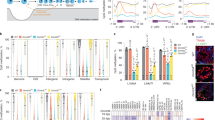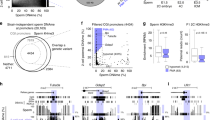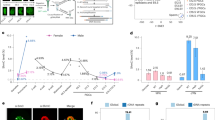Abstract
We have determined the status of DNA methylation at specific sites in three spermatogenesis–specific genes, Pgk–2, ApoA1 and Oct–3/4, throughout the development and differentiation of male germ cells in the mouse. We observed a specific demethylation event in the Pgk–2 gene in prospermatogonia at about the time of birth, about 10 days before the onset of transcription which first occurs in primary spermatocytes. All three genes were unmethylated in adult spermatogenic cells in the testis, but were remethylated in mature spermatozoa in the vas deferens. Surprisingly, we found that this remethylation is part of the process of sperm maturation which occurs in the epididymis.
This is a preview of subscription content, access via your institution
Access options
Subscribe to this journal
Receive 12 print issues and online access
$209.00 per year
only $17.42 per issue
Buy this article
- Purchase on Springer Link
- Instant access to full article PDF
Prices may be subject to local taxes which are calculated during checkout
Similar content being viewed by others
References
Cedar, H. DNA methylation and gene activity. Cell 53, 3–4 (1988).
Kafri, T. et al. Developmental pattern of gene-specific DNA methylation in the mouse embryo and germ line. Genes Devel. 6, 705–714 (1992).
McCarrey, J.R. Development of the germ cell. In Cellular and Molecular Biology of the Testis. (eds L. Ewing & C. Desjardins) 58–89 (Oxford University Press, New York, 1993).
Ariel, M., McCarrey, J. & Cedar, H. Methylation patterns of testis-specific genes. Proc. natn. Acad. Sci. U.S.A. 88, 2317–2321 (1991).
McCarrey, J.R. et al. Differential transcription of Pgk genes during spermatogenesis in the mouse. Develop. Biol. 153, 160–168 (1992).
Monesi, V. Ribonucleic acid and protein synthesis during differentiation of male germ cells in the mouse. Archs Anat. microsc. morph. Exp. 56 (suppl. 3/4), 61–74 (1967).
Singer-Sam, J., LeBon, J.M., Tanguay, R.L. & Riggs, A.D. A quantitative Hpall-PCR assay to measure methylation of DNA from a small number of cells. Nucl. Acids Res. 18, 687–692 (1990).
Benoit, J. Recherches anatomiques, cytologiques et histophyslologiques sur les voles excretrices du testicule chez les mammif ores. Arch. Anat. Histol. Embryol. (Strasb). 5, 175–412 (1926).
Monk, M., Boubelik, M. & Lehnert, S. Temporal and regional changes in DNA methylation in the embryonic, extraembryonic and germ cell lineages during mouse embryo development. Development 99, 371–382 (1987).
Sanford, J., Forrester, L., Chapman, V., Chandley, A. & Hastie, N. Methylation patterns of repetitive DNA sequences in germ cells of Mus musculus. Nucl. Acids Res. 12, 2823–2836 (1984).
Gebara, M.M. & McCarrey, J.R. Protein-DNA interactions associated with the onset of testis-specific expression of the mammalian Pgk-2 gene. Molec. cell. Biol. 12, 1422–1431 (1992).
Robaire, B. & Hermo, L. in The Physiology of Reproduction (eds Knobil, E. et al.) 999–1080 (Raven, New York, 1988).
Orgebin-Crist, M.-C. & Olson, G.E. Epididymal sperm maturation. in The Male in Farm Animal Reproduction (ed. Courot, M.) 80–102 (Martinus Nijhoff, Amsterdam, 1984).
Hamilton, D.W. in Frontiers in Reproduction and Fertililty Control Part 2 (eds Greep, R.O. & Koblinsky. M.A.) 411–426 (MIT, Cambridge, 1977).
Bedford, J.M. in Handbook of Physiology. Sect. 7, Bol. V (eds Hamilton, D.W. & Greep, R.O.) 303 (American Physiological Soc. Washington D.C, 1975).
Shemer, R., Walsh, A., Eisenberg, S., Breslow, J.L. & Razin, A. Tissue specific expression and methylation of the human apolipoprotein A1 gene. J. biol. Chem. 265, 1010–1015 (1990).
Walsh, A., Ito, Y. & Breslow, J.L. High levels of human apolipoprotein A-1 in transgenic mice result in increased plasma levels of small high density lipoprotein (HDL) particles comparable to human HDL3 . J. biol. Chem. 264, 6488–6494 (1989).
Rosner, M.H. et al. A POU-domain transcription factor in early stem cells and germ cells of the mammalian embryo. Nature 345, 686–692 (1990).
McGrath, J. & Solter, D. Completion of mouse embryogenesis requires both the maternal and paternal genomes. Cell 37, 179–183 (1984).
DeChiara, T.M., Robertson, E.J. & Efstradiadis, A. Parental imprinting of the mouse insulin-like growth factor II gene. Cell 64, 849–859 (1991).
Barlow, D.P., Stoger, R., Herrmann, B.G., Saito, K. & Schweifer The mouse insulin-like growth factor type-2 receptor is imprinted and closely linked to the Tme locus. Nature 349, 84–87 (1991).
Bartolomei, M.S., Zemel, S. & Tilghman, S.M. Parental imprinting of the mouse H19 gene. Nature 351, 153–155 (1991).
Chaillet, J.R., Vogt, T.F., Beier, D.R. & Leder, P. Parental-specific methylation of an imprinted transgene is established during gametogenesis and progressively changes during embryogenesis. Cell 66, 77–83 (1991).
Stoger, R. et al. Maternal-specific methylation of the imprinted mouse Igf2r locus identifies the expressed locus as carrying the imprinting signal. Cell 73, 61–71 (1993).
Brandeis, M. et al. The ontogeny of allele-specific methylation associated with imprinted genes in the mouse. EMBO J. 12, 3669–3677 (1993).
McCarrey, J.R., Hsu, K.C., Eddy, E.M., Klevecz, R.R. & Bolen, J.L. Isolation of viable mouse primordial germ cells by antibody-directed flow sorting. J. exp. Zool. 242, 107–111 (1987).
Hahnel, A.C. & Eddy, E.M. Cell surface markers of mouse primordial germ cells defined by two monoclonal antibodies. Gamete Res. 15, 25–34 (1986).
Bellve, A.R. et al. Spermatogenic cells of the prepuberal mouse. Isolation and morphological characterization. J. Cell Biol. 74, 68–85 (1977).
Romrell, L.J., Bellve, A.R. & Fawcett, D.W. Separation of mouse spermatogenic cells by sedimentation velocity. Devl. Biol. 49, 119–131 (1976).
Ben-Shushan, E., Pikarshy, E., Klar, A. & Bergman, Y. Extinction of Oct-3/4 gene expression in embryonal carcinoma x fibroblast cell hybrid is accompanied by changes in the methylation status, chromatin structure, and transcriptional activity of the Oct-3/4 upstream region. Molec. cell. Biol. 13, 891–901 (1993).
Okazawa, H. et al. The oct3 gene, a gene for an embryonic transcription factor, is controlled by a retinoic acid repressible enhancer. EMBO J. 10, 2997–3005 (1991).
Author information
Authors and Affiliations
Rights and permissions
About this article
Cite this article
Ariel, M., Cedar, H. & McCarrey, J. Developmental changes in methylation of spermatogenesis–specific genes include reprogramming in the epididymis. Nat Genet 7, 59–63 (1994). https://doi.org/10.1038/ng0594-59
Received:
Accepted:
Issue Date:
DOI: https://doi.org/10.1038/ng0594-59
This article is cited by
-
Chromatin alterations during the epididymal maturation of mouse sperm refine the paternally inherited epigenome
Epigenetics & Chromatin (2022)
-
LRWD1 expression is regulated through DNA methylation in human testicular embryonal carcinoma cells
Basic and Clinical Andrology (2021)
-
Male obesity impacts DNA methylation reprogramming in sperm
Clinical Epigenetics (2021)
-
Oxidative stress and male infertility: current knowledge of pathophysiology and role of antioxidant therapy in disease management
Cellular and Molecular Life Sciences (2020)
-
Testicular sperm is superior to ejaculated sperm for ICSI in cryptozoospermia: An update systematic review and meta-analysis
Scientific Reports (2018)



